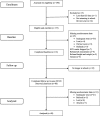A natural experiment of state-level physical activity and screen-time policy changes early childhood education (ECE) centers and child physical activity
- PMID: 32209069
- PMCID: PMC7092539
- DOI: 10.1186/s12889-020-08533-8
A natural experiment of state-level physical activity and screen-time policy changes early childhood education (ECE) centers and child physical activity
Abstract
Background: Early childhood education (ECE) centers are an important place for preschool-aged children to obtain physical activity (PA). A U.S. state government (Louisiana) recently updated requirements for licensed centers' PA and screen-time policies, which allowed for assessment of 1) ECE center practices, environment, staff behaviors, and policies changes on child-level PA and 2) state level changes on the ECE center.
Methods: ECE centers were assessed at the beginning of state licensing changes and 1-year later. The ECE centers were assessed via the Environmental Policy Assessment and Observation (EPAO) tool. The EPAO Sedentary Opportunities score, which primarily assesses television viewing time, was revised to reflect viewing non-television devices (e.g. tablets). Child-level PA was measured using accelerometry. For Aim 1, mixed models assessed ECE center changes and child PA with adjustment for demographic characteristics (fixed effects), baseline EPAO score (random effects), and clustering for center. For Aim 2, paired t-tests assessed ECE center environment differences between baseline and follow-up.
Results: Nine ECE centers participated and 49 preschoolers provided complete measures at both time points. For Aim 1, increases in the EPAO revised-Sedentary Opportunities score (as in less non-television screen-time) resulted in increased child PA (p = 0.02). For Aim 2, ECE centers improved their EPAO Active Opportunities and Staff Behaviors score (p = 0.04 and p = 0.02 respectively).
Conclusions: ECE centers improved their environment after 1-year, resulting in additional child PA. Changes in ECE centers environment, possibly through policy, can positively influence children's PA.
Conflict of interest statement
The authors declare that they have no competing interests.
Figures
Similar articles
-
LiveWell in early childhood: results from a two-year pilot intervention to improve nutrition and physical activity policies, systems and environments among early childhood education programs in South Carolina.BMC Public Health. 2021 May 13;21(1):919. doi: 10.1186/s12889-021-10975-7. BMC Public Health. 2021. PMID: 33985467 Free PMC article.
-
Physical activity and screen-viewing policies in Canadian childcare centers.BMC Public Health. 2019 Feb 4;19(1):145. doi: 10.1186/s12889-018-6290-z. BMC Public Health. 2019. PMID: 30717787 Free PMC article.
-
Active Early: one-year policy intervention to increase physical activity among early care and education programs in Wisconsin.BMC Public Health. 2016 Jul 20;16:607. doi: 10.1186/s12889-016-3198-3. BMC Public Health. 2016. PMID: 27439770 Free PMC article.
-
States lack physical activity policies in child care that are consistent with national recommendations.Child Obes. 2014 Dec;10(6):491-500. doi: 10.1089/chi.2014.0096. Child Obes. 2014. PMID: 25354331 Free PMC article. Review.
-
Effects of child care policy and environment on physical activity.Med Sci Sports Exerc. 2010 Mar;42(3):520-5. doi: 10.1249/MSS.0b013e3181cea3ef. Med Sci Sports Exerc. 2010. PMID: 20068496 Review.
Cited by
-
Associations between Community Built Environments with Early Care and Education Classroom Physical Activity Practices and Barriers.Int J Environ Res Public Health. 2021 Jun 17;18(12):6524. doi: 10.3390/ijerph18126524. Int J Environ Res Public Health. 2021. PMID: 34204363 Free PMC article.
-
Policy, systems, and environmental interventions addressing physical activity in early childhood education settings: A systematic review.Prev Med. 2023 Aug;173:107606. doi: 10.1016/j.ypmed.2023.107606. Epub 2023 Jul 4. Prev Med. 2023. PMID: 37414226 Free PMC article.
-
Thinking inside the box: The future of young children's physical activity and the home environment.Soc Sci Med. 2022 May;301:114930. doi: 10.1016/j.socscimed.2022.114930. Epub 2022 Mar 23. Soc Sci Med. 2022. PMID: 35344777 Free PMC article.
-
STRATEGIES IN ADDRESSING STATE SCREEN TIME POLICIES IN EARLY CARE AND EDUCATION CENTERS IN LOUISIANA.J La Public Health Assoc. 2022 Nov 15;3(1):44-58. J La Public Health Assoc. 2022. PMID: 36939439 Free PMC article.
-
Impact of the Play Active policy intervention on early childhood educator's sedentary behaviour-related practices, psychosocial influences and meeting policy recommendations: Results from a pragmatic cluster randomized trial.Pediatr Obes. 2025 Jun;20(6):e70005. doi: 10.1111/ijpo.70005. Epub 2025 Mar 11. Pediatr Obes. 2025. PMID: 40068962 Free PMC article. Clinical Trial.
References
-
- Hong I, Coker-Bolt P, Anderson KR, Lee D, Velozo CA. Relationship Between Physical Activity and Overweight and Obesity in Children: Findings From the 2012 National Health and Nutrition Examination Survey National Youth Fitness Survey. Am J Occup Ther. 2016;70(5):7005180060p1–7005180060p8. - PMC - PubMed
-
- Corcoran L, Steinley K, Grady S. Early Childhood Program Participation, Results from the National Household Education Surveys Program of 2016. U S Department of Education. NCES 2017 - 101. 2017. https://nces.ed.gov/pubSearch/pubsinfo.asp?pubid=2017101REV. https://nces.ed.gov/pubs2017/2017101REV.pdf.


